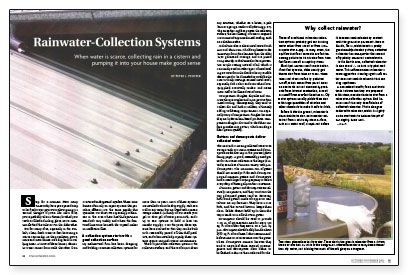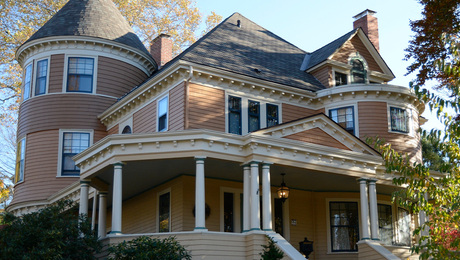Rainwater-Collection Systems
When water is scarce, collecting rain in a cistern and pumping it into your house make good sense.

Synopsis: An architect from Austin, Texas, explains how to design and build a rainwater collection system that stores drinking water in giant cisterns above or below ground. Especially useful in arid regions, the systems can store up to 10 months of drinking water for a family of four.
Stop for a moment. How many times today have you opened a tap to let fresh water pour out without giving it a second thought? If you’re like most folks, you’ve probably taken a shower, brushed your teeth or filled a drinking glass, not to mention flushed the toilet or run the dishwasher.
But for many of us, especially in the Sunbelt, clean, fresh water is fast becoming a scarce commodity. As the population grows, more and more homes are being built in outlying areas. At most of these homes, domestic water comes from wells that draw from overtaxed underground aquifers. These same homes often rely on septic systems that percolate effluent into the same aquifer that quenches our thirst. It’s especially problematic in this area where health-department standards vary widely and where the fractured limestone beneath the topsoil makes an ineffective filter.
A collection system starts with a good collection surface
My architectural firm has been designing and building rainwater-collection systems for more than 12 years. Most of these systems are installed with no backup supply, such as a well or city water, but are fitted with oversize storage instead. (A family of four needs 3000 gal. to 4000 gal. of water per month, and I try to size systems to hold at least ten months’ supply.) Over the years, these systems have evolved so that they can be built with reasonably priced off-the-shelf products, and when installed properly, these systems require minimal routine maintenance.
The first part of the collection system is the collection surface, and the roof on just about any structure, whether it’s a house, a pole barn or a garage, works well. The smoother and less porous the collection surface, the less filtering of water is required. I recommend unpainted-metal roofing, such as Galvalume Plus.
Galvalume Plus is sheet metal coated with zinc and aluminum. It holds up better to deterioration from the elements than the older G-90 galvanized coatings, and it is priced competitively. Galvalume Plus has a protective acrylic coating instead of oil, which is commonly used on other types of metal roofing. So water from the first few heavy rainfalls doesn’t need to be discarded as would be the case with oily coatings. Painted metal roofs, especially dark colors and even when factory-applied, eventually oxidize and create more stuff to be filtered out of water.
Composition shingles, clay tiles and concrete tiles are rougher and more porous than metal roofing. Consequently, they tend to collect dirt and harbor mildew, ultimately adding to filtering requirements. I’m especially wary of composition shingles because they are hydrocarbon-based products. Composition shingles also tend to shed their surface granules into gutters, which can clog a filter system quickly.
For more photos, drawings, and details, click the View PDF button below:

























